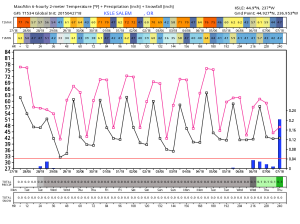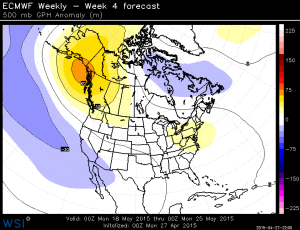Have you driven by one of the Willamette Reservoirs lately and wondered if they will actually fill for summer recreation? Good question!
Now let me point out that it’s perfectly normal to drive by Detroit Lake, Green Peter, Lookout Point, Cougar, & Hills Creek reservoirs in winter time and see them extremely low. That’s all the extra space left each fall for rainy-season flood events. The storage built into these reservoirs keeps us from seeing regular flood events in the Willamette River system (including Eugene, Salem, & Portland!) each winter.
Here’s a graph with a bunch of lines…it’s for Detroit Lake (east of Salem):

First, ignore the entire bottom half of the chart and focus instead on the thick red line on the upper part. That’s the “control curve” showing, in a perfect world, where officials want the level of the lake to be during each part of a normal year. Notice the lake is normally kept “full” from around May 1st to September 1st, then the level is dropped to the winter minimum by December 1st each year. It is kept there (if possible) through February 1st, then filling begins. That gives the Corp 3 months to “empty” reservoirs in the fall and 3 months to fill them in the late winter and spring. In the case of Detroit Lake the lake level varies about 113 ft. from “empty” to “full”.
Now look at the blue line…that’s the actual level over the past 12 months. Notice last summer the lake dropped a bit lower than preferred in the 2nd half of summer and then followed the “curve” more or less through the fall and early winter. As a meteorologist it’s interesting to note the wintertime spikes when heavy rainfall suddenly fills the reservoir. In late December the level jumped about 40′ in a very short period of time! February 1996 must have been crazy! On that blue line you can also see that right after a heavy precipitation event lots of water is poured downriver to quickly bring the level back down to where it should be in winter.
Two things I’ve noticed in the past few months: They started allowing it to fill earlier than normal this year (mid/late January) since it was obvious ridging was going to stick around that point with its dry weather. Then you can see how the filling is going much more slowly this year. A week from now (May 1st) the lake would typically be “full”. Not this year! Looks like it is running about 45′ below the curve right now, which means as you drive by it’s only as full as it would typically be in late February or early March.
So will it fill? Most likely NO. But that doesn’t mean no boating! Here’s a forecast from the Army Corps of Engineers from about a week ago:

The purple line on the left side is the past and then future forecasts (and levels right now) begin at the dotted line. The blue line is the most likely scenario, assuming normal precipitation/conditions over the next month or two. The red line is the line in which there’s only a 5% chance it’ll get above that. Looks like officials think it’s most likely the lake will top out around 1450’…about 13-14′ below full pool. What does that mean for boating?
Take a look at (ONE MORE) chart for the past 7 days:

This one shows all the boat ramp elevations. There is one that’s available all year long…the low water ramp. But the current level is still at least 20-55 feet below all the other ramps. The good news is that most of those ramps should be available this summer according to the forecast levels up above. You’re just going to have to wait a bit longer to get on the water this year!
I didn’t look into any forecast for other reservoirs…although you can find all the info on the Army Corps of Engineers Willamette Basin Web Page. You can see all the reservoirs are well below normal in this graphic:

So don’t panic if you have party plans on “the lake”…there WILL be some water to play on!
Chief Meteorologist Mark Nelsen




 Posted by Mark Nelsen
Posted by Mark Nelsen 


















